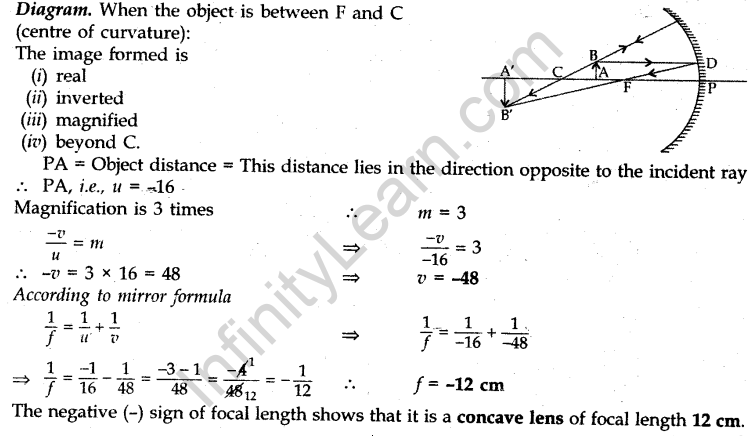Table of Contents
Science SA2 Delhi – 2012
Time allowed: 3 hours Maximum marks: 90
GENERAL INSTRUCTIONS:
- The Question Paper comprises of two Sections, A and B. You are to attempt both the Sections.
- All questions are compulsory.
- All questions ofSection-A and all questions ofSection-B are to be attempted separately.
- Question numbers 1 to 3 in Section-A are one mark questions. These are to be answered in one word or in one sentence.
- Question numbers 4 to 6 in Section-A are two marks questions. These are to be answered in about 30 words each.
- Question numbers 7 to 18 in Section-A are three marks questions. These are to be answered in
about 50 words each. - Question numbers 19 to 24 in Section-A are five marks questions. These are to be answered in about 70 words each.
- Question numbers 25 to 36 in Section-B are questions based on practical skills. Question nos. 25 to 33 are MCQs. Each question is a one mark question. You are to select one most appropriate response out of the four provided to you. Question nos. 34 to 36 are short answer questions carrying two marks each.
SET I
SECTION A
Question.1 Name the functional group present in each of the following organic compounds:
(i)C2H5Cl (ii) C2H5OH
Answer. Functional group present in:
(i) C2H5Cl — Chloro (halide)
(ii)C2H5OH — alcohol
Question.2 What will be the colour of the sky when it is observed from a place in the absence of any atmosphere?
Answer. The colour of sky will be black when it is observed from a place where atmosphere is absent as dispersion of light does not take place when there is no atmosphere.
Question.3 Which class of chemicals is linked to the decrease in the amount of ozone in the upper atmosphere of the earth?
Answer.The depletion of ozone layer is due to the use of chemicals called chlorofluorocarbons.
Question.4 List two advantages of vegetative reproduction practised in case of an orange plant.
Answer. Advantages of vegetative reproduction in case of an orange plant:
- In case an orange plant is grown from seeds it may take many years before it starts to bear fruit. But if the plant is grown from vegetative reproduction, it starts bearing fruits much earlier.
- Seedless oranges can be obtained by this method.
Question.5 How can the valency of an element be determined if its electronic configuration is known? What will be the valency of an element of atomic number 9 (nine)?
Answer. Valency of an element can be determined by knowing its valence electrons which can be determined by knowing the electronic configuration.
The elements with valence electrons 1 to 4. Their valencies are also equivalent to their respective valence electrons.
The elements with valence electrons 5 to 8. Their valencies correspond to (8 – V.E.).
Atomic number = 9 Electronic configuration = 2, 7
Valence electrons = 7 Valency = 8-7 = 1
Question.6 An element ‘X’ has atomic number 11:
(a) Write its electron configuration, (b) State the group to which ‘X’ belongs?
(c) Is ‘X’ a metal or a non-metal? (d) Write the formula of its bromide.
Answer.

Question.7 Explain the variation of the following properties of the element in the periodic table.
- Atomic radius in a period.
- Metallic character in a period.
- Valency in a group.
Answer.
- On moving from left to right in a period of the periodic table, the atomic radius of elements decreases.
- On moving from left to right in a period, the metallic character of elements decreases and non-metallic character increases.
- and non-metallic character increases.
As the number of valance electrons in a group is the same, all the elements in a group have the same valency.
Question.8 (a)Name any four varieties of vegetables which have been produced from ‘wild cabbage’ by the process of artificial selection.
(b)Give one example of an evolutionary change produced in an organism for one purpose which later on becomes more useful for a different function.
Answer.
(a)Cabbage, broccoli, kale, kohlrabi are evolved from wild cabbage by artificial selection.
(b)Sometimes an evolutionary change produced in an organism for one purpose later on becomes more useful for an entirely different function. For example: Birds have evplved feathers as a means of providing insulation to their bodies in cold weather but later on these feathers became more useful for the purpose of flying.
Question.9 Subhash has started the project of constructing his building. His architect suggested that he should add a system of rain water harvesting in his building. He thought by adopting water harvesting in his project he can solve his water crisis problem in the years to come.
(i)Is Subhash correct in his approach? Support your answer.
(ii)Give the value shozvn by Subhash.
Answer.
(i)Rain water collected on the roof is not alloroed to go into the drain. It is allowed to percolate under the ground by a specially made passage so as to recharge the ground-water. This process is called rain water harvesting.
Advantages of rain water harvesting:
- Rain water stored as underground ivater does not evaporate.
- ‘The water stored in ground does not promote breeding of mosquitoes.
- It is protected from contamination by human and animal waste.
- This water recharges wells.
(ii)Water is precious. We should not waste it.
Question.10 A student cannot see a chart hanging on a wall placed at a distance of 3 m from him. Name the defect of vision he is suffering from. How can it be corrected? Draw ray diagrams for the
- defect of vision and also
- for its correction.
Answer. If a student cannot see the object clearly placed at a distance of 3 m from him then he is suffering from Myopia or Short Sightedness.
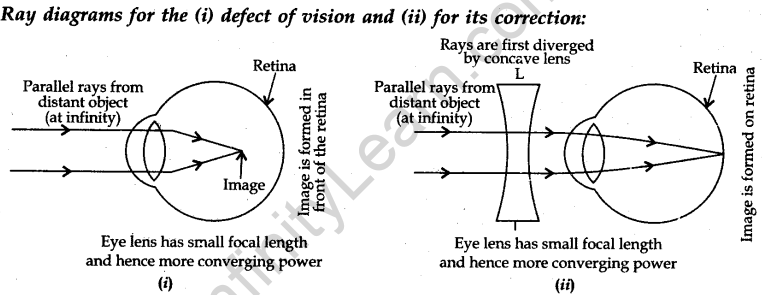
Question.11 The image of a candle flame placed at a distance of 45 cm from a spherical lens is formed on a screen placed at a distance of 90 cm from the lens. Identify the type of lens and calculate its focal length. If the height of the flame is 2 cm, find the height of its image.
Answer.
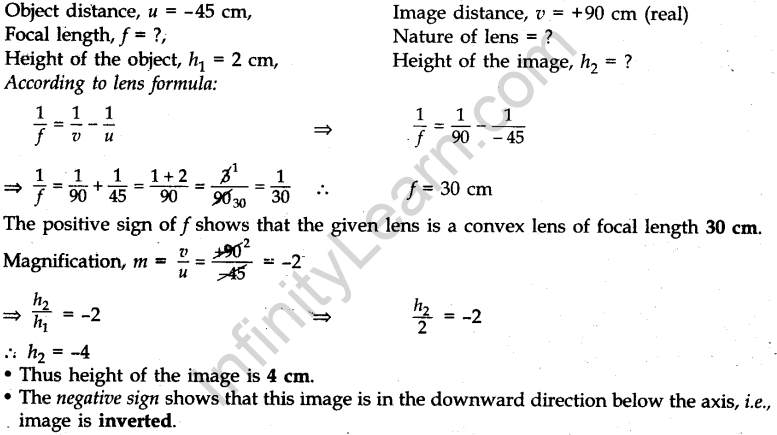
Question.12 State the type of mirror preferred as
- rear view mirror in vehicles,
- shaving mirror.
Justify your answer giving two reasons in each case.
Answer.
- Convex mirror is used as rear view mirror in vehicles because the image formed in a convex mirror is highly diminished thus a convex mirror gives a wide field of view. Therefore a convex mirror enables a driver to view a much larger area of the traffic , behind him.
- Concave mirror is used as shaving mirror because when face is held within the focus of a concave mirror, an enlarged image of the face is seen in the concave mirror.
Question.13 What are isomers? Draw the structures of two isomers of butane,C4H10.Why can’t we have isomers of first three members of alkane series?
Answer.The organic compounds having the same molecular formula but different structures are known as isomers.
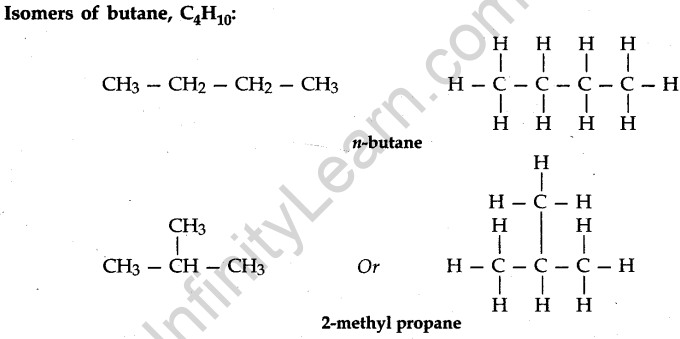
Isomerism is not feasible in the first three members of the alkane series (methane, ethane, and propane) since they contain just one, two, or three carbon atoms, respectively, and it is not possible to have distinct configurations of carbon atoms with only 1,2 or 3 carbon atoms.
Question.14 F, Cl and Br are the elements each having seven valence electrons. Which of these
- has the largest atomic radius,
- is most reactive? Justify your answer stating reason for each.
Answer. F, Cl and Br belong to the same group (17th) as each has the same number of valence elements ‘7.
- Out of F, Cl and Br, Bromine has the largest atomic radius because on going down in a group of the periodic table, the size of atoms increases as the number of the electron shells of electrons is added to the atoms at every step.
- Out of F, Cl and Br, Fluorine is the most reactive because the chemical reactivity of non-metals decreases on going down in a group of the periodic table as moving down in a group of non-metals, the size of the atoms goes on increasing. Thus the nucleus of atoms goes deeper and deeper inside it and hence the attraction for the incoming electrons decreases. Therefore the tendency of atoms to gain electrons decreases, due to which their reactivity decreases.
Question.15 Explain the meaning of sexually transmitted diseases (STDs). Give two examples of STDs each, caused due to
- bacterial infection and
- viral infection. State in brief how the spread of such diseases may be prevented.
Answer. The diseases which are spread by sexual contact with an infected person are called sexually transmitted diseases (STDs).
- Gonorrhoea and Syphilis are some common STDs caused by bacteria.
- AIDS (Acquired Immuno Deficiency Syndrome) and Genital Warts are some examples of STDs caused by viruses.
The spread of such diseases may be prevented by educating people in high risk groups, : screening tests for blood donors and mutually faithful monogamous relationships.
Question.16 A blue colour flower plant denoted by BB is crossbred with that of white colour flower plant denoted by bb.
(a) State the colour of flower you would expect in their F1 generation plants.
(b) What must be the percentage of white flower plants in F2 generation if flowers of F1 plants are self-pollinated?
(c) State the expected ratio of the genotypes BB and Bb in the F2 progeny.
Answer.
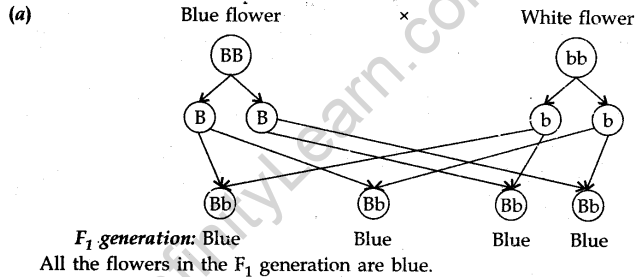
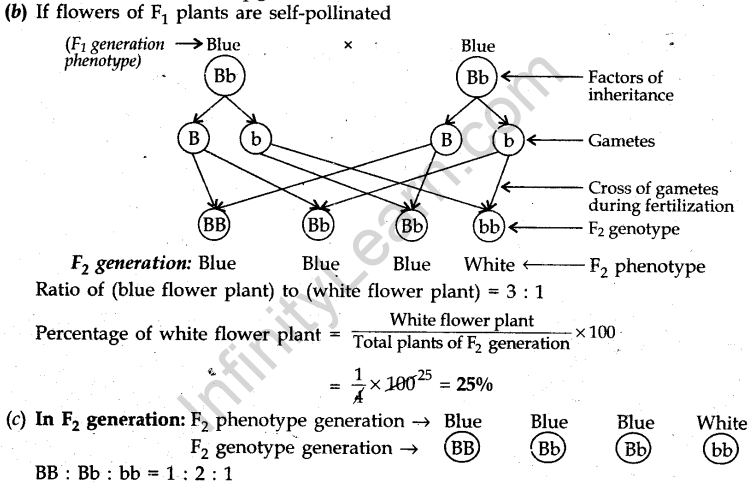
Question.17 What is meant by the term speciation? List four factors which could lead to speciation.
Answer. The process by which new species develop from the existing species is known as speciation. Important factors which could lead to the formation of a new species are as follows:
- Genetic drift caused by drastic changes in the frequencies of particular genes by chance alone.
- Geographical isolation of a population caused by various types of barriers like moun¬tain ranges, river, sea etc. The geographical isolation leads to reproductive isolation due to which there is no flow of genes between separated groups of population.
- Variation caused in individuals due to natural selection.
- Sometimes the sub-population becomes reproductively isolated by ecological barriers. Therefore it occurs within the same geographical area and within the original population. –
Question.18 Distinguish between homologous organs and analogous organs. In which category would you place wings of a bird and wings of a bat? Justify your answer giving a suitable reason.
Answer.
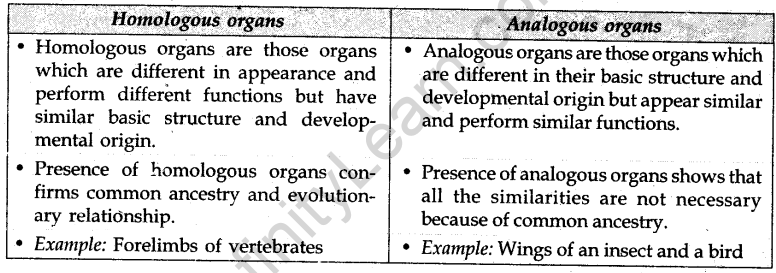
Reason. Wings of a bird and wings of a bat are homologous organs because they have similar basic design.
Question.19 List in tabular form three physical and two chemical properties on the basis of which ethanol and ethanoic acid can be differentiated.
Answer.
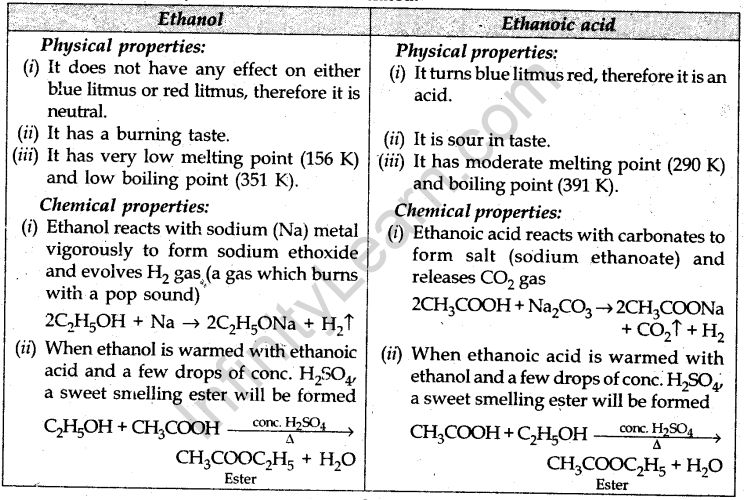
Question.20 State the law of refraction of light that defines the refractive index of a medium with respect to the other. Express it mathematically. How is refractive index of any medium ‘A’ with respect to a medium ‘B’ related to the speed of propagation of light in two media A and B? State the name of this constant when one medium is vacuum or air. The refractive indices of glass and water with respect to vacuum are 3/2 and 4/3 respectively. If the speed of light in glass is 2×108 m/s, find the speed of light in (i) vacuum, (ii) water.
Answer. The second law of refraction gives a relationship between the angle of incidence and the angle of refraction. This law is also known as Snell’s Law of Refraction.
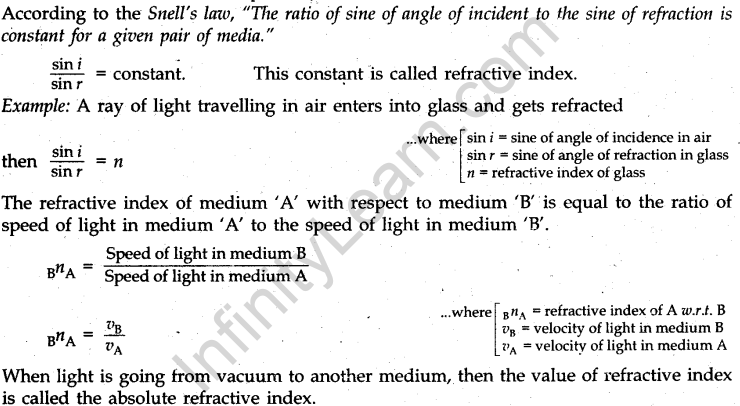
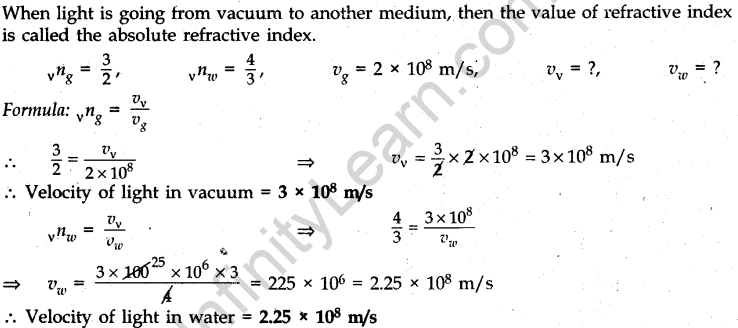
Question.21 List the sign conventions for reflection of light by spherical mirrors. Draw a diagram and . apply these conventions in the determination of focal length of a spherical mirror which forms a three times magnified real image of an object placed 16 cm in front of it.
Answer. Sign conventions for reflection of light by spherical mirrors.
- All the distances are measured from pole of the mirror as origin.
- The object is always placed to the left of the mirror.
- Distances measured in the direction of incident light are considered to be positive (+ve).
- Distances measured against the direction of incident light are considered to be negative (-ve).
- The perpendicular distances to the principal axis in the upward direction are considered to be positive (+ve).
- The perpendicular distances to the principal axis in the downward direction are considered to be negative (-ve).
u = object distance v = image distance f = focal length
h = height of the object h = height of the image
P = Principal axis C = Centre of curvature F = Focus


Question.22 What is the difference between the chemical composition of soaps and detergents? State in brief the action of soaps in removing an oily spot from a shirt. Why are soaps not considered suitable for washing where water is hard?
Answer. Difference between the chemical composition of soaps and detergents:

Action of soaps. See Q. 20(b), 2011 (I Delhi). [Page P – 7
Soaps are not considered suitable for washing where water is hard. See Q. 20(a), 2011 (Delhi). [Page P-6
Question.23 Define the terms pollination and fertilisation. Draw a diagram of a pistil showing pollen tube growth into the ovule and label the following:
pollen grain, male gamete, female gamete, ovary.
Answer. Pollination: Pollination is the transfer of pollen grains from the anther of a stamen to the stigma of a carpel. Pollination occurs only in plants. Pollination can occur in two ways: (a) self pollination and (b) cross pollination. It is a physical process.
Fertilisation: The fusion of a male gamete with a female gamete to form zygote is called fertilisation. Fertilisation occurs in plants as well as in animals. Fertilisation is also of two types: (a) external fertilisation and (b) internal fertilisation. It is a biochemical process.
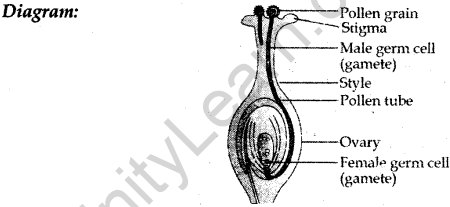
Question.24 Describe in brief the role of
- testis
- seminal vesicle,
- vas deferens,
- ureter and
- prostate gland in human male reproductive system.
Answer. Role in human male reproductive system:
- Testis. Testis is the main reproduction organ of the male reproductive system. There are two testes located outside the abdominal cavity in scrotum because sperm forma¬tion requires a lower temperature than the normal body temperature. So testis pro¬duces male germ cells (sperms). Testis also produces male sex hormone (testosterone).
- Seminal vesicle. Seminal vesicle is a pair of male reproductive glands present between the rectum and urinary bladder. It secretes seminal fluid which is alkaline and neutralises the acidity of urine and activates sperms.
- Vas deferens. Vas deferens or sperm duct is a long tube which joins the testes with another tube called urethra coming from the bladder. The sperms formed in the testis are delivered through the vas deferens to urethra.
- Ureter. These are a pair of long, narrow, thin-walled and tubular structures which start from the hilum of the kidneys, ran downward and open in urinary bladder. These conduct the urine from the kidneys to urinary bladder.
- Prostate gland. It is a single, large sized & lobulated gland present just below the urinary bladder. It adds its secretion to the sperm which provides nutrition to the sperms.
SECTION B
Question.25 The colour of a freshly prepared solution filled in a test tube is pale green. The solution could be:
(A) Zinc sulphate (B) Ferrous sulphate
(C) Copper sulphate (D) Aluminium sulphate
Answer. (B) Ferrous sulphate
Question.26 A student prepared an aqueous solution of CuSO4 in beaker X and an aqueous solution of FeSO4 in beaker Y. He then dropped some iron pieces in beaker X and some zinc pieces in beaker Y. After about 10 hours he observed that the solutions in X and Y respectively appear:
(A) blue and green (B) colourless and pale green
(C) colourless and light blue (D) greenish and colourless
Answer.(D) greenish and colourless
Question.27 A student adds 4 ml of acetic acid to a test tube containing 4 mL of distilled water. He then shakes the test tube and leaves it to settle. After about 10 minutes he observes:
(A) a layer of water over the layer of acetic acid
(B) a layer of acetic acid over the layer of water
(C) a precipitate settling at the bottom of the test tube
(D) a clear colourless solution
Answer. (D) a clear colourless solution
Question.28 To determine focal length of a concave mirror a student obtains the image of a well lit distant object on a screen. To determine the focal length of the given concave mirror he needs to measure the distance between:
(A) mirror and the object
(B) mirror and the screen
(C) screen and the object
(D) screen and the object and also mirror and the screen
Answer.(B) mirror and the screen
Question.29 To determine the focal length of a convex lens by obtaining a sharp image of a distant object we generally follow the following steps which are not in proper sequence.,
(A) Hold the lens between the object and the screen
(B) Measure the distance between the lens and the screen
(C) Select a well lit distant object
Answer.(B) Measure the distance between the lens and the screen
Question.30 A student traces the path of a ray of white light through a rectangular glass slab and marks the angles of incidence (∠i), refraction (∠r) and emergence (∠e) as shown. Which angle or angles has he NOT marked correctly?
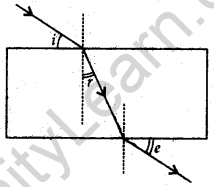
(A) ∠i only (B) ∠i and ∠r
(C) ∠i and ∠e (D) ∠r and∠e
Answer. (C) ∠i and ∠e
Question.31 After viewing different slides, a student draws following which depicts binary fission in amoeba.

Answer.(C) C
Question.32 After observing the prepared slides of binary fission in amoeba and budding in yeast . following observations were reported:
(A) Single cells of amoeba and yeast were undergoing binary fission and budding respectively.
(B) Cytokinesis was observed in the yeast cell.
(C) Elongated nucleus was dividing to form two daughter nuclei in amoeba.
(D) A chain of buds was observed due to reproduction in amoeba.
The correct observation(s) is/are:
(A) A and C (B) B only (C) C and D (D) D, A and C
Answer. (A) A and C
Question.33 While performing the experiment with raisins to determine the percentage of water absorbed by them, a student made following measurements:
Mass of water in the beaker = 40 g
Mass of raisins before soaking = 5 g
Mass of raisins after soaking for 2 hours = 8 g
Mass of water left in the beaker after the experiment = 35 g
The percentage of water absorbed by raisins is:

Answer.
![]()
Question.34 How will you distinguish between a concave mirror and convex mirror in the laboratory?
Answer.
- Concave mirror forms both inverted and erect image of the object.
Convex mirror forms only erect image. - Erect image formed by a concave mirror is magnified in size.
Erect image formed by a convex mirror is always diminished in size.
Question.35 Can we test hard water by using detergent? Write one more method other than using soap to test the hardness of hard water.
Answer. We cannot use detergent for testing hard water. As detergents form lather in both hard water and soft water.
Method to test the hardness of water. If on boiling the water, some insoluble salt’s precipitates (white ppt.) are formed, these precipitates then settle down and can be removed by filtering the water. The given sample of water is then hard,water.
Question.36 Out of potato, sweet potato, radish and carrot; make pairs of Homologous organs and Analogous organs.
Answer. Radish and carrot both are homologous organs as these are modified roots.
Potato and sweet potato are analogous organs, as these both are underground structures and store food. But potato is a stem and sweet potato is an underground modified root,
SET II
Except for the following questions, all the remaining questions have been asked in Set-I.
SECTION A
Question.1 Name the functional group present in each of the following compounds:
(i) HCOOH (ii) C2H5CHO
Answer. Organic compound:
(i) HCOOH
(ii) C2H5CHO
Functional group:
(i) Carboxylic acid ( —COOH)
(ii) Aldehyde (—CHO)
Question.2 The sky appears dark instead of blue to an astronaut. State its reason.
Answer. There is no atmosphere containing air in space to scatter sunlight. As there is no scattering of light in space, the scattered light does not reach the eyes and the sky appears dark instead of blue to an astronaut in outer space.
Question.3 Depletion of ozone in the ozone layer is a cause for our worry. Why?
Answer. Depletion of ozone in the ozone layer is a cause for our worry because if the ozone layer in the atmosphere disappears completely, then all the extremely harmful ultraviolet radiations coming from the Sun would reach the earth. These ultraviolet radiations would cause skin cancer and other ailments hi men and animals, and also damage the plants.
Question.4 How does a growing embryo get nutrition from the mother’s blood?
Answer.There is a special tissue developed between the uterus wall and embryo called placenta. It is through the placenta that all the requirements of the developing foetus like nutrition, respiration and excretion etc. are met from the mother’s body.
Question.5 State the modern periodic law for classification of elements. How many
- groups and
- periods are there in the modern periodic table?
Answer.
- Groups = 18,
- Periods = 7
Question.6 An element ‘M’ has atomic number 11:
(a) Write its electron configuration(b) State the group to which ‘M’ belongs?
(c) Is ‘M’ a metal or a non-metal? (d) Write the formula of its chloride.
Answer.

Question.10 The image of a candle flame placed at a distance of 30 cm from a spherical lens is formed on a screen placed at a distance of 60 cm from the lens. Identify the type of lens and calculate its focal length. If the height of the flame is 2.4 cm, find the height of its image.
Answer.
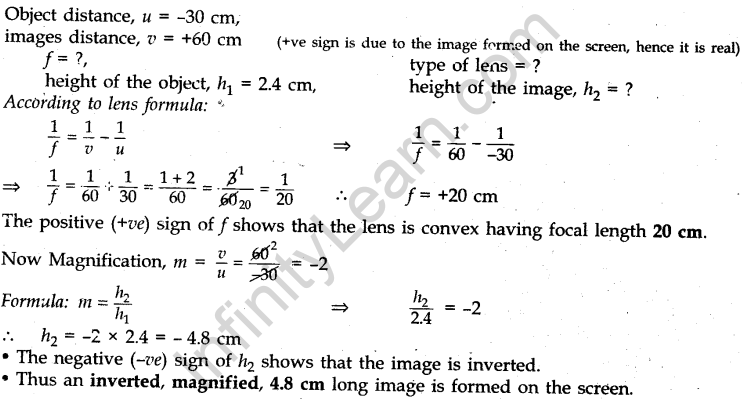
Question.14 Define homologous series of organic compounds. List its two characteristics. Write the name and formula of the first member of the series of alkenes.
Answer.A homologous series is a group of organic compounds having similar structures and similar chemical properties in which the successive compounds differ by CH2 group. Characteristics
of homologous series:
- All the members of a homologous series can be represented by the same general formula.
- The difference in the molecular mass of any two adjacent homologues is 14 u.

Question.17 State and describe in brief any three main factors responsible for the rise of a new species.
Answer. See Q. 17, 2012 (I Delhi). [Page P – 33
SET III
Except for the following questions, all the remaining questions have been asked in Set-I and
Set-11.
SECTION A
Question.1 Name the functional group present in each of the following organic compounds:
(i) CH3COCH3(ii) C2H5COOH
Answer. Organic compound Functional group
(i) CH3COCH3 (>C = O) Ketonic group
(ii)C2H5COOH (-COOH) Carboxylic acid
Question.2 Which phenomenon is responsible for making the path of light visible?
Answer. Tyndall effect is responsible for making the path of light visible.
Question.3 Which class of carbon compounds is responsible for the depletion of ozone layer at the higher level of the atmosphere?
Answer. The depletion of ozone layer is due to the use of chemicals called chlorofluorocarbons.
Question.4 List four properties of the image formed by a concave mirror when object is placed between focus and pole of the mirror.
Answer. Characteristics of image formed by a concave mirror when object is placed between focus and pole of the mirror.
Image is virtual, erect, magnified, i.e., bigger than the object and behind the mirror.
Question.5 Define the term puberty. List two changes observed in girls at the time of puberty.
Answer. Puberty. The age at which the sex hormones (or gametes) begin to be produced and the boy and girl become sexually mature (able to reproduce) is called puberty.
Generally boys attain puberty at the age of 13 to 14 years while girls reach puberty at the age of 10 to 12 years.
Changes observed in girls at the time of puberty are—mammary glands develop and enlarge; menstruation starts.
Question.6 What is meant by asexual reproduction. List its any two different forms.
Answer. Asexual reproduction. The production of a new organism from a single parent without the involvement of sex cells is called asexual reproduction.
Different forms: (i) fission and (ii) budding.
Question.10 The image of a candle flame placed at a distance of 36 cm from a’spherical lens is formed on a screen placed at a distance of 72 cm from the lens. Identify the type of lens and calculate its focal length. If the height of the flame is 2.5 cm, find the height of the image.
Answer.

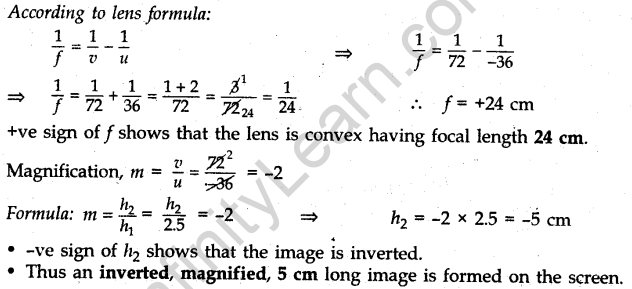
Question.11 An element ‘M’ has atomic number 12:
(a) Write its electronic configuration.
(b) State the group to which ‘M’ belongs.
(c) State the period to which ‘M’ belongs.
(d) State the valency of ‘M’.
(e) Is ‘M’ a metal or a non-metal?
If) Write the formula of its oxide.
Answer.

Question.17 Define the term ‘evolution’. “Evolution cannot be equated with progress.” Justify this statement.
Answer.Evolution. Evolution is the sequence of gradual changes which take place in the primitive organisms over millions of years in which new species are produced.
Evolution cannot be equated with progress. More and more complex body designs have emerged and evolved over time, but this does not mean that the older designs are inefficient. One of the simplest life for bacteria came into being very early in evolution is still surviving in the present conditions. Bacteria inhabits the most inhospitable habitats like hot springs, deep sea, thermal vents and ice in Antarctica. But human beings, have a body design which is best suited to their environment and supports their existence.
Question.18 Complete the following equations:

Answwer.




